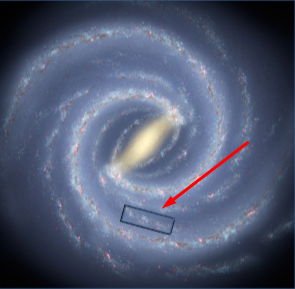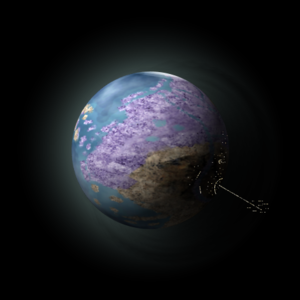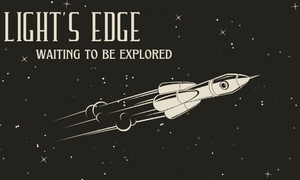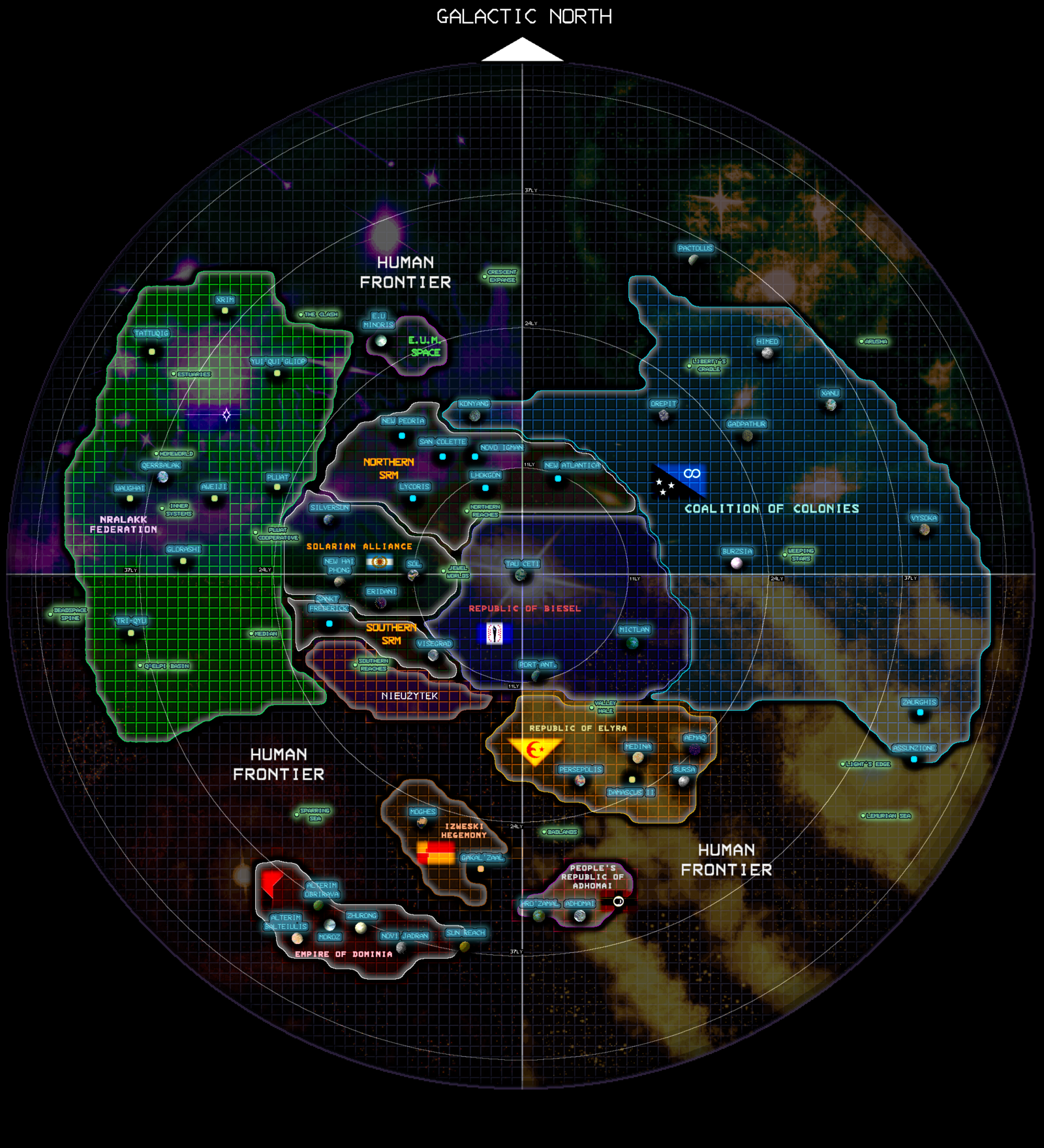The Orion Spur
Orion Spur
Overview
This is a page for the regional descriptors and starmap of the Orion Spur, the setting of the Aurora server's universe.
The Orion Spur is the center of all things familiar in the galaxy, yet is largely unexplored by even the most noteworthy Skrell and Human expeditions. It represents a tiny portion of a much larger galaxy that is indicative of a thriving and lush interstellar community. At least, the hope is that whatever lay beyond could be considered such.
The Orion Spur is traditionally charted in a horizontal two-dimensional fashion imposed over the Milky Way. This is due to the fact that the density of noteworthy locations is rather thin and spread out evenly across its internal regions. This is not to say the galaxy is not three dimensional - however for your ease of comprehension, it will not be treated as such.
To the Galactic North of the Orion Spur (closer toward the galactic center in this definition) is the Sagittarius Arm, and to the Galactic South (further from the galactic center) would be the Perseus Arm.
Details as to the background of the Orion Spur can be found here. This region of space (or perhaps all of space if this is any indicator) is particularly anomalous, and some of its anomalies can be detailed on the Deep Space page.
Details on the regions of, and factions within the Orion Spur can be found below.
Regions
Solarian Alliance
The Alliance of Sovereign Solarian Nations is the single largest political entity in known space. Nearly half of Humanity can trace their home to here.
Jewel Worlds
Centered in the heart of the Sol Alliance and largely safe from any common galactic dangers, the Jewel Worlds are the pride of Humanity to some, and a massive bane to others. Here is where the first colonization from Humanity arose, and where the Interstellar War was powered, producing an extremely polarized mindset against it amongst the Colonial territories. Nearly sixty billion Humans can be found here with an undetermined amount of aliens.
Among the Jewel Worlds are the entirety of the Sol star system, Epsilon Eridani, New Hai Phong, and Silversun.
The Jewel Worlds possess two bluespace gates, one from Sol to Konyang - which is in the process of being dismantled - and another from Epsilon Eridani to Qerrbalak.
Alliance Neutral Zone
A massive region of neutral space established over two hundred years ago during the time after the Interstellar War, the “ANZ” is a testament to the Coalition’s fear. Both the Alliance and Coalition have long since built their borders around this demilitarized zone, taking great care to not officially overstep their boundaries and create hostilities. However, it is very clear the Alliance itself has long cared little for this zone, regularly “accidentally” pushing survey fleets into its boundaries. The ANZ entirely encompasses the Weeping Stars region.
As of the KING OF THE WORLD arc's finale in late 2462, the ANZ no longer exists.
Coalition of Colonies
The Coalition of Colonies is the second largest Human entity in known space, regarded highly in the Frontier as a bastion of hope against the burgeoning Solarian Alliance. Over 85 billion people reside across the entire Coalition, with all relatively evenly spread out.
Central Coalition
The focal point of the Coalition, home to the Xanu Prime Free League and Himeo - both powerhouses in their own regard. It spans roughly 50 square lightyears of space and is known for its countless mineral-rich systems.
Weeping Stars
Not only a large memorial to the Interstellar War, the region known grimly as the Weeping Stars is perhaps the sole place the war occurred. Before the modern Coalition came to be, the war was fought over several lightyears of territory as the conflict raged on. Nearly 800 square lightyears saw the worst of the battles, leading the region to be later referred to after the tears caused by the bloodshed.
Rebel’s Reach
Among the greatest standing acts of defiance against the Solarian Alliance in the modern day, Rebel’s Reach is a portion of the Frontier dotted with Coalition trade posts and secure travel routes. It is the most common route to and from the Coalition due to its position outside of the former Neutral Zone permitting safe travel under the umbrella of either side’s defense forces. Now that the ANZ no longer exists, this route is commonly trafficked due to leftover defense installations still remaining staffed and providing safe coverage all the same.
Orepit is located in Rebel’s Reach.
Human Frontier and Colonial Space
The Human Frontier consists of any amount of open space that is charted but is left without any major galactic sovereignty. This is seen as lawless, wild space to some while untold billions call it home. Colonial territories such as Elyra or Dominia are the few bastions of solid civilization in this chaotic place.
The Clash
The Clash is the farthest point of the Human Frontier and the closest settlement of Human territories to Nralakk Federation space, with some independent factions practically floating on the border of it.
Arusha
Arusha is a truly alien sector within the Orion Spur, known for its great many barely-habitable planets populated by xenoflora that is like nothing ever seen elsewhere in charted space. Presumably anomalous in nature or spread by a now long-gone civilization, these Arushan plant species are widely famous for their odd appearance, high luminescence and very specific compatible habitats. The products of harvesting Arushan plants are seen as delicacies across charted space.
Badlands
The Badlands are home to some of the Orion Spur’s most savage flora and fauna, a phenomenon that attracts only the wildest and wisest of the system’s inhabitants - xenobiologists, weapon scientists, there’s even a market for mercenaries, in the hunting of the particularly large and lethal creatures. Of course, there are also those looking to make a life for themselves, but natives aren’t known to treat settlements kindly.
The majority of the People's Republic of Adhomai and the Republic of Elyra’s space finds itselves positioned in the Badlands. As well, the entire Izweski Hegemony and a small portion of the Empire of Dominia.
The Badlands are accessible by a set of bluespace gates leading to and from Tau Ceti and Persepolis/New Ankara.
Valley Hale
Nestled in the narrow Frontier space between the Republic of Elyra and the former borders of the Solarian Alliance is Valley Hale, a large region filled with a large amount of old, dying stars and impassable nebulae. Due to close proximity to patrols on either end of this space, it isn’t frequented much by criminal elements and is one of the safer parts of the known Frontier. After 2462, the Republic of Elyra has occupied the majority of Valley Hale, now bordering the Republic of Biesel.
Sparring Sea
A large region of heavily contested space, mostly avoided, barring those with lofty goals or sinister dealings. It is populated by all sorts of outcasts and outlaws, but notably Unathi pirates and exiles, Dominian edict breakers and even the scarce eccentric band of Skrell are all known to seek refuge here. Though piracy is common, plenty of stubborn colonies of all backgrounds make stakes here.
Light’s Edge
An astrological curiosity, Light’s Edge is the end of colonized space in its direction. The area beyond it is devoid of major stars, and ships that pass near it often report feelings of unease amongst the crew. Settlements are extremely rare in Light’s Edge, and those that are present have a nasty habit of tearing themselves apart internally.
Crosk Plains
A large, mostly uncontrolled area, the Crosk Plains represent the furthest stretches of human colonization - stretching up against the skrellian border. The Coalition of Colonies, Nralakk Federation, and Solarian Alliance are currently attempting to expand their influence into this region with varying degrees of success.
Nralakk Federation
The Nralakk Federation is an authoritarian, centralized union of star systems. Although humans have fractured heavily in their expansion, Skrell have remained in a largely singular government through strict reinforcement of education, travel, technology and research, while its laws and planned economy organised by the Grand Council further allow the Federation to control the direction of the nation. Social media is maintained by the Federation government, which gags unacceptable discussions or thoughts and instead encourages people to be like the Idols that they reward with credits, high-quality housing, and fine living.
The Homeworld
The geographical and strategic centre of the Nralakk Federation, the Homeworld region encompasses the entirety of the Nralakk system, the origin point for the Skrell species. The region is considered the "jewel" of the Federation, being both the most affluent and most influential system of the nation, as well as housing almost a quarter of the Orion Spur's total Skrell. It has a single Bluespace gate, connecting the system to Humanity's Episilon Eridani.
Qerrbalak, Qerr'Malic, and Aliose are noteworthy planets within the Homeworld region.
Inner Systems
The Inner Systems are parts of the Nralakk Federation that were the first to be colonised by Skrell, and have had centuries, if not thousands of years of development. This region sees a high quality of life and technological standing on par with the Homeworld, which gradually begins to decline as one reaches the border with the Traverse. Older colonies have become specialised in one way or another, while the "newer" colonies focus almost purely on manufacturing as they transition from resource extraction to refining and production. The Inner Systems are divided between the '''First Waves''', colonies that were established early in the age of Skrell colonisation, and the '''Second Waves''', which were established much later to further support Qerrbalak and its colonies.
Aweiji is located in the Inner Systems.
The Traverse
The Traverse is the frontier of Federation society. Research and mining outposts, newly-established colonies, and manufacturing facilities can be found dotted throughout this large-spanning section of Federation space. While the quality of life and purpose of settlements in the Traverse vary drastically, they will all follow similar trends based on which district they are in. The Traverse is also home to independence movements, resistance cells, and other criminal organisations that operate in Federation space.
Tattuqig and Xrim are located in the Traverse.
Pluat Ven’qop - The Pluat Cooperative
The “crown” of the Traverse, the Pluat Ven’qop (or the Pluat Cooperative) is host to much of the Traverse’s industrial facilities. Besides Pluat itself, several other planets and megafactory stations take in raw resources imported in from other areas in the Traverse or the Spur at large for manufacturing civilian and military goods for the Federation. Though, the majority of the goods produced here are necessities rather than luxury items.
The standard of living is comparable to living within the Contingent Systems, thanks to the importance and support the Federation places on the district. Qukala Patrols are a common sight here and piracy rates are extremely low. Technologically speaking, citizens enjoy advanced industrial designs and slightly outdated, but enjoyable luxury devices.
Qukala-Median Treqki - The Median
Also known as the Median Naval District, it was created shortly after first contact with the Solarian Alliance, this district was to serve as a firm wall between human and skrell territory. The Qukala established several military bases and patrol outposts in the region to handle potential piracy, be it Humans preying on Skrell or vice versa. The region was largely unoccupied prior to the Qukala’s establishment in the area, outside of a few mining and agricultural colonies. Thanks to warm relations with the Alliance, the Qukala never had to make much use of their power here, until the Solarian Warlord States arrived in force. Recently, occasional skirmishes have broken out in the Median as opportunistic raiders swelled in numbers in the wake of the collapse of Solarian authority.
Skrell from the Median are few and far between, especially those that decided to venture out in the Spur. Most of the population are farmers, miners, Qukala, and those that make up the services to support them. The planets in the district were developed enough for the Qukala to purchase local food rather than importing it from the inner worlds, but little more support than that has been received from the Federation.
Q'elpi - The Q’elpi Basin
The Skrell residing in the “Basin” of the Traverse do not often feel the touch of Nralakk’s hand in their affairs, for better or worse. The region is largely decentralized with administrations being planetary in nature rather than covering large swathes of space. The Basin is home to barely habitable planets and plenty of asteroid fields. Outside of initial construction and colonization efforts, the Federation has provided nearly no extra support to the Basin. Most colonies and habitats get by via trading minerals and valuable gasses for food and domestic goods.
During the phoron crisis, it was revealed that around a dozen systems in the Q'elpi region were secretly collaborating with the Ti'Rakqi, the largest group of Marauders in Federation space. When the Qukala and local Nlomkala attempted a mass arrest of the civilian Government for their part in the collaboration, the systems quickly broke into open defiance of the Federation Government. The "Marauder Systems", as they came to be known, are currently under martial law as slow progress is being made to pacify them. The Federation has publicly stated its intention to return the systems back to a civilian Government once the collaborators have been detained and "dissident activity" has ceased.
Zeiqi-Trqn - The Deadspace Spine
The portion of the Traverse situated towards galactic west near uncharted space is aptly dubbed the “Deadspace Spine” when translated from Nral’Malic. The region was one of the first colonization targets of pre-Glorsh skrell. The colonies and installations here are very old, very occupied, and very lawless.
Due to the Tri-Qyu incident, much of the skrellian infrastructure in place to keep their interstellar empire intact was rendered inoperable, setting the species back with resounding force. Due to the distance, the Zeiqi-Trqn was one of the final areas of pre-Glorsh space to be “reclaimed” by the Nralakk Federation.
This reclamation took quite some time though, and during the decades prior, the skrell in the Zeiqi-Trqn recovered their ability to traverse the stars earlier than most due to their distance from the Tri-Qyu system. They lacked sufficient industrial power to produce the fuel and other necessities required to return to the core worlds, and instead opted to engage in communal trade to keep the region breathing until they could be found.
A few decades before rediscovery, a plague swept through the Zeiqi-Trqn. Its origins are unknown and widely speculated about, popular theories being that it was a Glorsh-Omega bio-weapon or some unknown bacteria from Deadspace. Regardless, the “Black-Blood” caused the blood of a victim to cease transmission of oxygen to the cells, eventual corruption of DNA and caused the body to use carbon instead of mercury in its blood, causing its infamous black color. The plague wiped out a few of the fledgling colonies completely and severely damaged the populace of the remaining planets and stations. Authority collapsed and the region descended into anarchy.
Desperate skrell turned towards piracy and exploitation to stay alive. Colonies were raided and burned, rival pirate fleets fought for any scraps of fuel or food, and countless others died from the indiscriminate conflict. When the Federation arrived, little was left to save. The Grand Council condemned the area as a “lost cause” and enacted measures to destroy colonies, ships, and stations suspected to contain traces of the Black-Blood. To this day, there is no cure to the disease, only early treatment can prevent cases from becoming terminal. Any skrell suspected of visiting the region is subject to screening to avoid spreading it to the Federation core.
Inside the Zeiqi-Trqn itself, skrell who refuse to bend the knee to Nralakk, prefer to live more criminal lives, or simply lack the power to go elsewhere live in squalor. The region receives no support from the Nralakk Federation, and no regular patrols outside of the ones on its border.
Estuaries
The Estuaries are considered the final frontier for Skrellian expansion, being one of the few directions the Nralakk Federation can expand without encroaching on its neighbour's borders. The region is mostly comprised of small developing colonies, termed "Boundary Worlds" or "Boundaries" for short. The Estuaries are almost a perfect location for independence movements and other illegal operations to flourish; the lack of infrastructure and value found in the Estuaries has resulted in Qukala patrols being few and far between, allowing for Marauders, Lyukal cells, and anti-Federation agitators to operate with unparalleled freedom.
The Estuaries have learned to rely less on the Federation, with colonies adopting a more "generalist" plan compared to the specialised societies found elsewhere in the Federation to facilitate trade and survival. Technology and quality of life within this segment of the Traverse can vary wildly, but usually ranks lower than elsewhere in the Federation as a result of the colonies here either being newly established or lacking the resources to develop to what's considered standard in the modern-day.
The Starmap
The Orion Spur
The Starmap; expand the collapsible, and feel free to open the image link in a new tab for a closer and more detailed look! ▶











